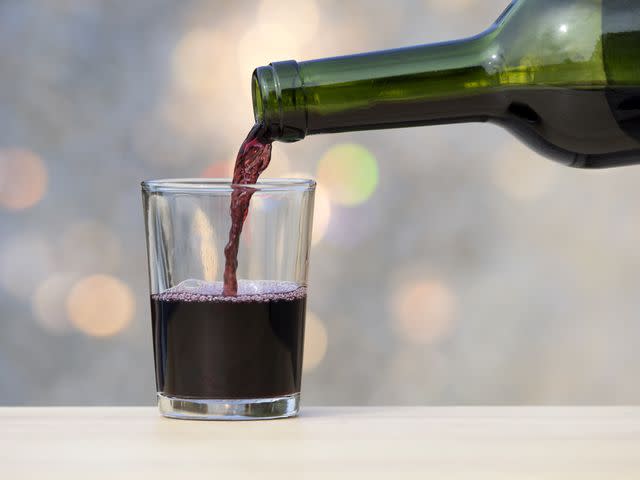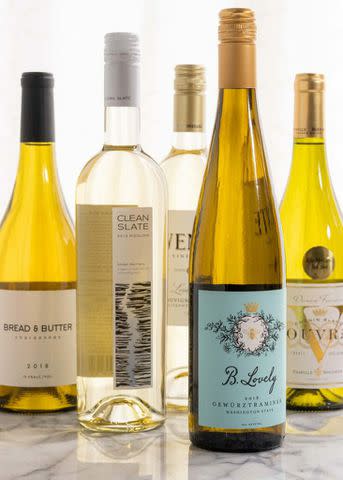This Is How Long an Open Bottle of Wine Will Last
Plus, three ways to tell if your wine has gone bad.
You opened a Pinot Noir with dinner and after putting the kids down for the night, you're so exhausted you leave the open bottle sitting on the kitchen counter and go straight to bed too. The next morning, you wonder if you can drink the remaining wine or if you should pour it down the drain. (If you're thinking, "there's no such thing as leftover wine," you haven't met a tired parent that rather sleep.) According to wine experts, it depends. Here’s why.

Simply Recipes / Getty Images
How long a bottle of wine will last after you’ve opened it depends largely on two factors: the type of wine and how it’s stored.
In general, table wines last three to five days after they’ve been opened. Dessert wines like Port and Sherry last much longer; some wine experts say months or even years. Here’s a breakdown of how long wine lasts by type:
Sparkling Wines
Sparkling wines, like Champagne and Prosecco, lose their carbonation quickly after opening. The bubbles protect the wine from oxidation (damage from oxygen). Within a few days, the wine will be flat, which means you can't drink it anymore. Use a special sparkling wine stopper to help slow oxidation and maintain some pressure for the bubbles.
Don't toss flat sparkling wine. Cook with it—in Garlic Chicken or Summer Vegetable Risotto.
Light White Wines and Rosés
While the flavor may change a bit within the first day after opening, light white wines can last five to seven days if closed with a cork and stored in the refrigerator. The wine will lose some of its vibrancy and you may notice bright fruity flavors like pear or apple become less pronounced, but it’s still drinkable.
Read More: Wine Expert Recommends Serving Wine With Potato Chips—Here Are His Favorite Pairings

Simply Recipes / Alison Bickel
Full-Bodied White Wines
Oaked wines, like Chardonnay and Viognier, can last three to five days after opening. These wines are often aged in oak barrels, which are not airtight, which makes them heartier against oxygen. They can last a bit longer than sparkling wine. Vacuum caps will give you more time than a simple cork stopper.
Red Wines
If you stopper red wines with a cork and keep them in a cool, dark place, you can still drink them three to five days after you open them. Red wines contain more tannins and natural acidity, which protect from oxidation. The more tannins in a wine, the more they can withstand exposure to air. Light reds, like Pinot Noir or Beaujolais, which are low on the tannin scale, won’t last as long in an open bottle as deeply rich reds like Petite Sirah or Shiraz.
In temperatures above 70°F, the wine will turn bad more quickly, so place them in the fridge if you don't have a dedicated wine cooler.
Read More: How to Freeze Wine
Dessert Wines
Dessert wines have been fortified with grape spirits or brandy. The brandy protects the wine against spoilage and lends it a very long shelf life and a high alcohol content.
Some fortified wines, like Madeira and Marsala, are oxidized and cooked before they’re made, so their shelf life is significantly longer. Oxygen can do little damage to them. Once you’ve opened a fortified wine, cork it and store it in a cool, dark place.
3 Ways To Tell If Your Wine Has Gone Bad
To determine if your opened bottle of wine can go another round, keep these three checks in mind:
Look: Pour a glass of red wine. Did it go from vibrant ruby red to a tawny brown? It's likely oxidized and not worth drinking.
Smell: Give the wine a smell. Does it smell like vinegar? It has already turned.
Taste: You’ll know immediately if it's edible or a lost cause. Some wines may be past their prime, but still plenty delicious. It’s all about how it tastes to you. Note that "bad" wine won’t be dangerous or toxic to consume—you won’t get sick sipping a Syrah that’s past its storage prime.
A version of this article originally appeared on MyRecipes.com.


